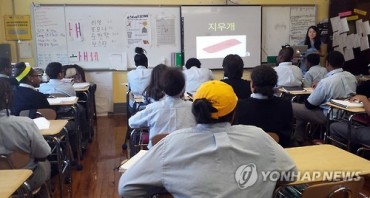
This file photo taken Feb. 8, 2024, shows a building housing cram schools in Seoul’s Mokdong. (Image courtesy of Yonhap)
SEOUL, Mar. 14 (Korea Bizwire) — Spending on private education for South Korean students reached an all-time high in 2023 despite the fall in the student population, data showed Thursday.
Total expenses on private after-school classes for primary, middle and high school students stood at 27.1 trillion won (US$20.6 billion) last year, reaching a record high, up 4.5 percent from a year earlier, according to the data compiled by Statistics Korea.
The average monthly spending on private education per student also rose 5.8 percent on-year to 434,000 won.
When taking those who actually enrolled in private education programs into consideration, the per-month expenses came to 553,000 won, marking a 5.5 percent on-year increase.
The increase came even though the total number of students dropped 1.3 percent on-year to 5.21 million in 2023.
The proportion of students who participated in private education, such as cram schools, or “hagwons” in Korean, also inched up 0.2 percent on-year to 78.5 percent.
For elementary school students, the rate came to 86 percent, and that for middle and high schoolers came to 75.4 percent and 66.4 percent, respectively.
Students here spent 7.3 hours on private education programs per week on average last year. In detail, elementary school students spent 7.5 hours, middle schoolers 7.4 hours and high school students 6.7 hours, the data showed.
South Korea is widely known for its high enthusiasm for education, as many consider entering prestigious universities a key to success in the highly competitive society.
Excessive private education burdens have often been blamed for being a factor behind the country’s ultra-low birth rate, and the government has come up with measures to curb the rising expenses.
Last year, the government vowed to remove so-called “killer questions” from college entrance exams and to have more questions within the curriculum at public schools. It also pledged to enhance the monitoring of and crackdown on private education cartels.
The country’s total fertility rate, which is the average number of expected births from a woman in her lifetime, fell to a record quarterly low of 0.65 in the fourth quarter of 2023.
(Yonhap)






